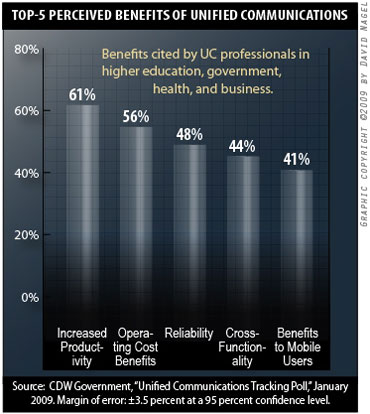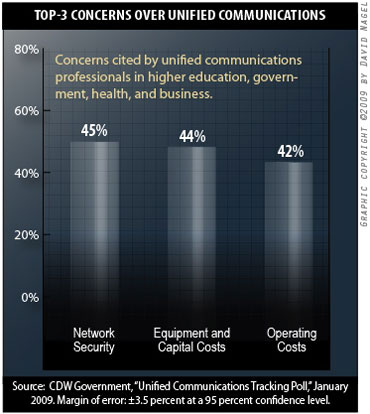Unified Communications Adoption Gaining Momentum
Despite the largely weak economy, adoption of unified communications among higher education, government, and other organizations is continuing on track. According to data released this week by CDW Government, 53 percent of IT professionals are reporting being in some phase of implementation, with 70 percent of these expecting to complete their deployments within two years.
The information is based on a survey of 766 IT professionals in business, government, higher education and healthcare. It's the first of several in a series of Unified Communications Tracking Polls to be released by CDW-G in the coming year. It showed that 20 percent of these organizations are actively implementing unified communications at present, with 33 percent reporting that they are in the planning stages of implementation. (There's a margin of error of ±3.5 percent at a 95 percent confidence level.)
Across all sectors, the highest ranked perceived benefits were increased productivity (61 percent), operating cost reductions (56 percent), reliability of communications (48 percent), improved "cross-functional" communication (44 percent), and benefits for remote or mobile workers (41 percent).

Among higher education professionals specifically, increased productivity led the pack at 65 percent, followed by reduction of operating costs (53 percent) and increased reliability of communications (49 percent). (There is a margin of error of ±8.0 percent at a 95 percent confidence level for education-specific data in the survey.)
"Unified communications promises so many benefits that many organizations are eager to find a solution as quickly as possible," said Ken Grimsley, vice president of strategic sales at CDW Corporation, in a statement released to coincide with the findings. "Forty-one percent of responders said they are assessing their opportunity for UC--a wise first step because successful implementation depends on a well conceived migration plan. The best solution addresses the readiness of the organization's network and includes the organization's applications that will benefit most from integration with UC."
The survey also took a look at challenges UC professionals believe they face moving forward with a unified communications implementation. These included 45 percent of respondents indicating network security as a concern, 44 percent citing equipment and capital costs, and 42 percent citing operating costs.

Significantly lower percentages of those who have begun or completed their UC implementations cited these concerns: 27 percent for network security, 28 percent for equipment and capital costs, and 31 percent for operating costs.
Further information about the poll, including a complete, downloadable PDF of the poll results, can be found here.